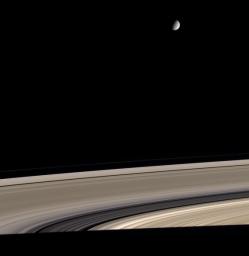
|
Bright Ice, Dirty Ice
- Click the image above for a larger view
- Full-Res JPEG (969 x 997) (39.9 kB)
- Full-Res TIFF (969 x 997) (2.9 MB)
Caption:
Saturn's icy moon Enceladus hovers above Saturn's exquisite rings in this color view from Cassini. The rings, made of nearly pure water ice, have also become somewhat contaminated by meteoritic dust during their history, which may span several hundred million years. Enceladus shares the rings' nearly pure water ice composition, but appears to have eluded dust contamination through resurfacing processes that scientists are still trying to understand. Enceladus is 505 kilometers (314 miles) across.
Dust affects the rings' color, while differences in brightness are attributable to varying particle sizes and concentrations.
The images for this natural color view were taken with the Cassini spacecraft narrow-angle camera on April 5, 2005, at a distance of approximately 2.2 million kilometers (1.4 million miles) from Saturn through red, green and blue spectral filters. The image scale is 13 kilometers (8 miles) per pixel.
Background Info:
The Cassini-Huygens mission is a cooperative project of NASA, the European Space Agency and the Italian Space Agency. The Jet Propulsion Laboratory, a division of the California Institute of Technology in Pasadena, manages the mission for NASA's Science Mission Directorate, Washington, D.C. The Cassini orbiter and its two onboard cameras were designed, developed and assembled at JPL. The imaging team is based at the Space Science Institute, Boulder, Colo.
For more information about the Cassini-Huygens mission visit http://saturn.jpl.nasa.gov . For additional images visit the Cassini imaging team homepage http://ciclops.org .
Cataloging Keywords:
| Name | Value | Additional Values |
|---|---|---|
| Target | Enceladus | Saturn, Saturn Rings |
| System | Saturn | |
| Target Type | Satellite | Planet, Ring |
| Mission | Cassini-Huygens | |
| Instrument Host | Cassini Orbiter | |
| Host Type | Orbiter | |
| Instrument | Imaging Science Subsystem (ISS) | |
| Detector | Narrow Angle Camera | |
| Extra Keywords | Color, Dust, Visual, Water | |
| Acquisition Date | ||
| Release Date | 2005-05-20 | |
| Date in Caption | 2005-04-05 | |
| Image Credit | NASA/JPL/Space Science Institute | |
| Source | photojournal.jpl.nasa.gov/catalog/PIA06653 | |
| Identifier | PIA06653 | |
